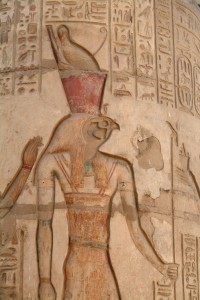Mythic Monday: Glorious Horus
June 19, 2017
In Egyptian mythology, Horus is the son of the gods Osiris and Isis, the rulers of Egypt. The kingdom flourished under this divine couple until the jealous god of disorder, Seth, murdered Osiris and seized the throne. Isis, who was pregnant, fled to the marsh islands of the Nile River, where she gave birth to Horus. To keep the newborn god hidden from the evil Seth, Isis kept Horus in a papyrus thicket. In this place, known as the Nest of Horus, he was watched over and raised by Hathor, the goddess of the sky.

In this relief carving from the Temple of Kom Ombo in Egypt, a falcon-headed Horus wears the double crown of ancient Egypt. Credit: © Gary Cook, Alamy Images
After Seth learned that Osiris had an heir, he became angry and fearful. Seth knew that the throne rightfully belonged to Horus, and he feared Horus would someday overthrow him. Seth tried to kill young Horus, taking the form of such animals as hippopotamuses or serpents to raid Horus’s nest in disguise. However, the child god thwarted all Seth’s murderous attempts. This story is often told in the hieroglyphics of scrolls and tombs, where Horus is shown as a royal child overpowering dangerous animals. Horus is also sometimes depicted as a man with the head and wings of a falcon. In this form, he is a sky god and protector of royalty.
Seth used any opportunity to attack Horus, who dodged the attacks and retaliated with clever tricks and pranks. In one tale, Seth ripped out Horus’ eye and buried it in a mountainside, where the eye grew into a lotus flower. Hathor used her loving powers to nurture the flower until it matured into a replacement eye for Horus. In another story, Horus challenged Seth to a race in stone boats. Seth accepted the challenge and built a stone boat, but Horus built a wooden boat and painted it gray to give it the appearance of stone. Predictably, Seth’s boat sank in the Nile as Horus floated on and won the race.
Seth eventually succeeded in killing Horus with the poisonous sting of a scorpion. Distraught over her son’s death, Isis cried out to the other gods for help. The sun god, Re, and Thoth, the moon god and scribe of the underworld, took pity on Isis. Re paused time by stopping his daily path across the sky, as Thoth recited a magic spell over Horus’ body. The scorpion’s poison then flowed out of Horus, and he was brought back to life.
Horus grew to be a strong and mighty god. To defeat Seth and other enemies, he took the form of a great winged disk, and this became his symbol. The lengthy war between Horus and Seth eventually ended in a trial, in which it was decided that Horus, as the son of Osiris, would take the throne. Horus enjoyed a long and celebrated reign over Egypt, and for centuries, ancient Egyptians referred to their kings as the “Horus.”


